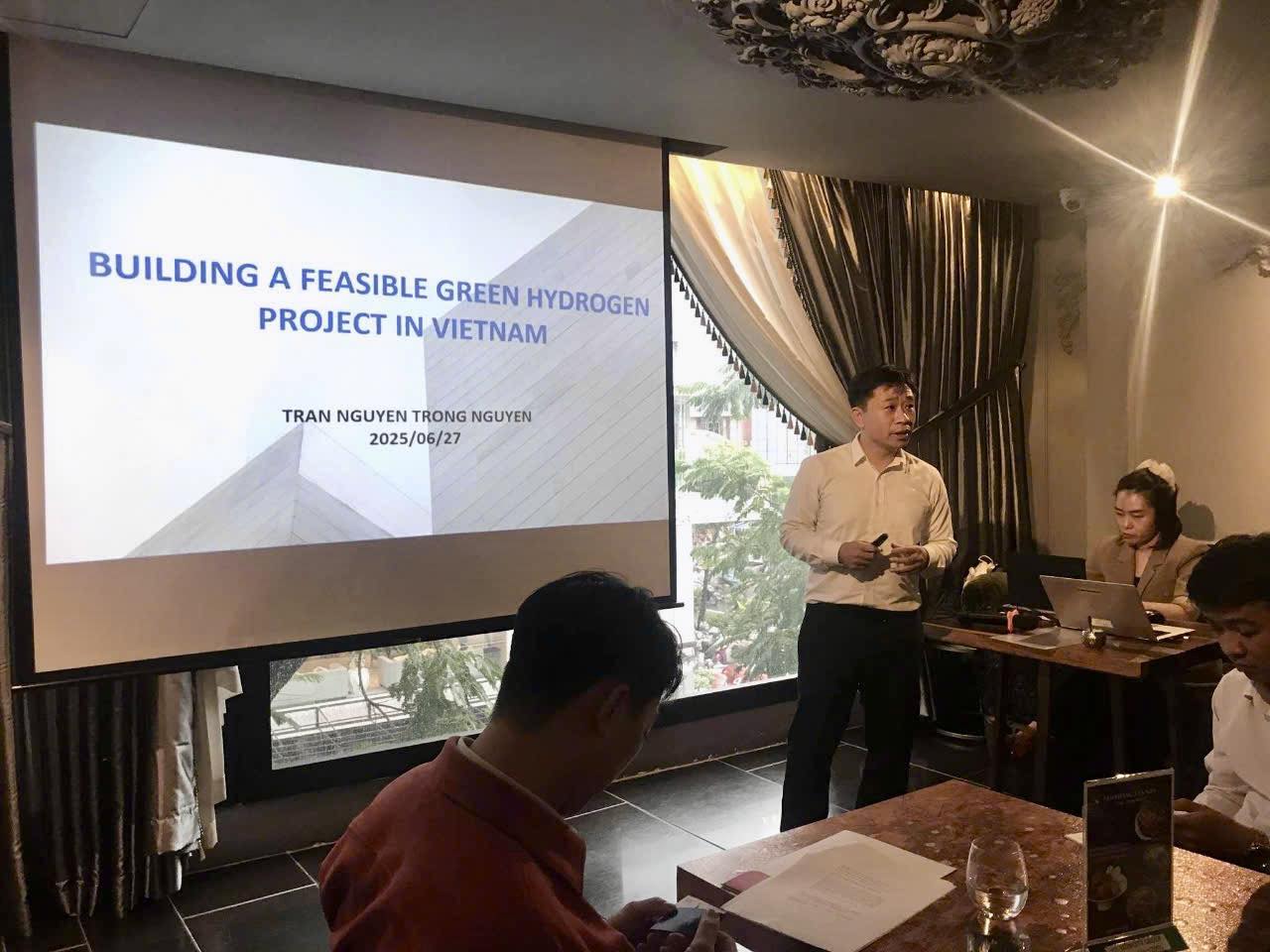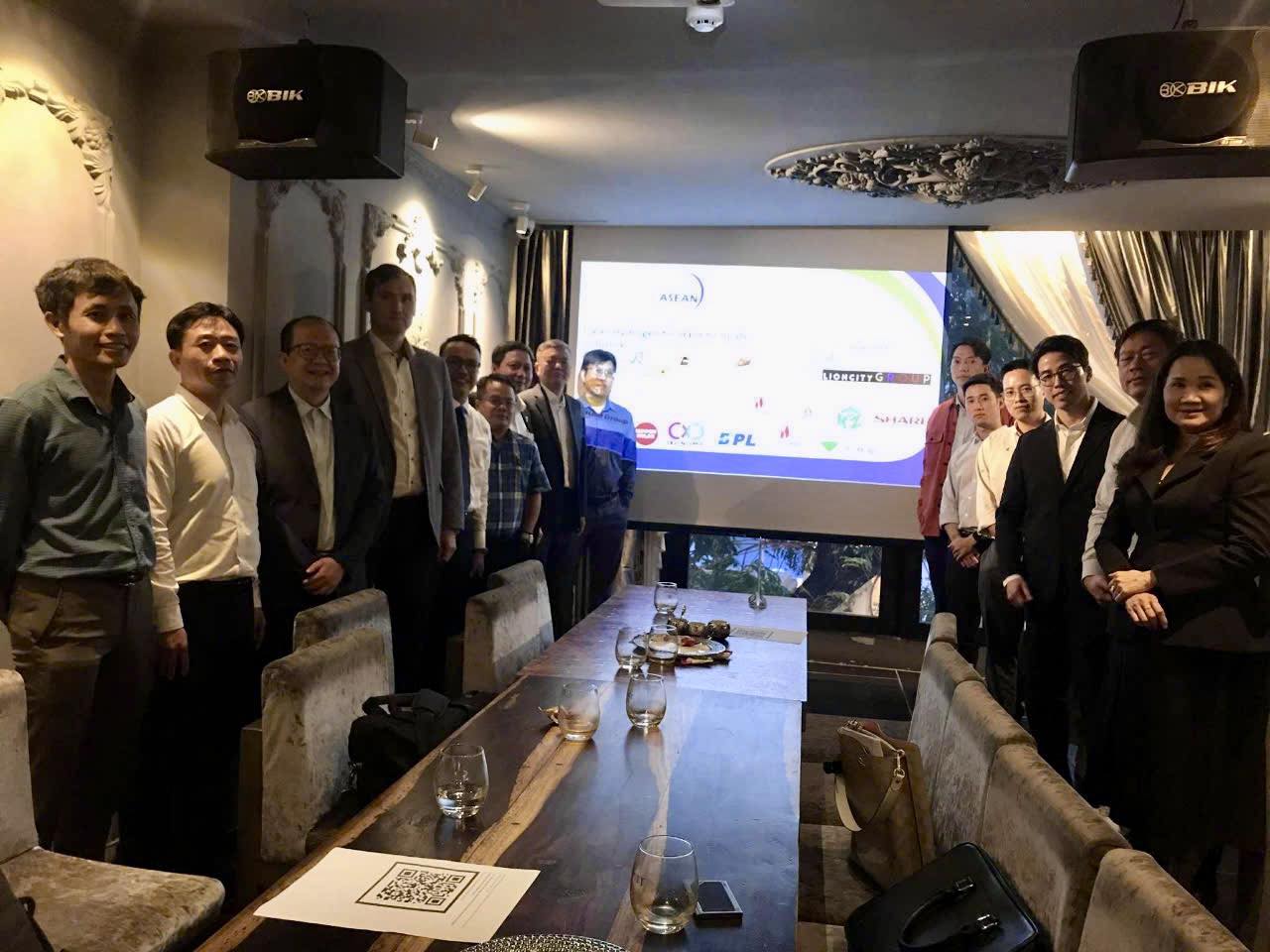Building a Feasible Green Hydrogen Project in Vietnam (By Dr. Tran Nguyen, Chairman of Kenzen Consulting)
Sectors: Stakeholders in Renewable Energy, Hydrogen Development, and Vietnamese Infrastructure
Presented by Dr. Tran Nguyen Trong Nguyen (Kenzen Consulting)
Date: June 27, 2025 at VAHC Seminar on Clean Hydrogen - Technology and Solution for Hard-to-Abate Industries and Innovative Financing Solution for Hydrogen Project for Fishing Industry in Vietnam and ASEAN.

Executive Summary
This report synthesizes the key findings and proposal presented by Dr. Tran Nguyen Trong Nguyen regarding Vietnam's green hydrogen potential and Obayashi Corporation's strategy for implementing a pilot project. Vietnam possesses immense renewable resources (over 1,000 GW potential) but faces grid constraints limiting utilization. Leveraging Obayashi's global hydrogen supply chain expertise, the proposal aims to use curtailed solar power to produce green hydrogen for local industrial use, bypassing grid limitations, reducing CO₂ emissions, and establishing a scalable model for Vietnam's energy transition.
1. Vietnam's Green Hydrogen Strategy & Potential
-
Net Zero Commitment: Vietnam targets carbon neutrality by 2050 (COP 28 announcement).
-
National Hydrogen Strategy: Formalized targets for green and blue hydrogen production:
-
2030: 100,000 – 500,000 tons/year
-
2050: 10 – 20 million tons/year
-
-
Role in Power Generation (PDP VIII):
-
Hydrogen and Ammonia (NH₃) identified as key fuels for decarbonizing thermal power generation.
-
Significant shift planned in generation structure:
-
Table 1: Vietnam's Projected Electricity Generation Mix
Source 2030 (162.25 GW) 2050 (577.43 GW) Notes Coal 32.42 GW 30.12 GW Transitioning to NH₃/Biomass LNG 44.81 GW 37.33 GW Transitioning to LNG+H₂ Renewables (Wind/Solar) ~30-39% ~67-71% PDP VIII Target -
-
-
Global Context: Aligns with US, EU, and Japan strategies emphasizing Hydrogen for Carbon Neutrality, Energy Security, and Economic Development.
2. Renewable Energy Landscape in Vietnam: Foundation & Challenges
-
Immense Potential: >1,000 GW total renewable potential identified:
-
Wind Power: ~650 GW (Onshore & Offshore)
-
Solar Power: ~380 GW
-
-
Ambitious Targets (PDP VIII):
-
2030: 158 GW total capacity; 30-39% from Wind/Solar (~47-62 GW).
-
2050: 573 GW total capacity; 67-71% from Wind/Solar (~384-407 GW).
-
-
Significant Opportunity Gap: Current planned Wind/Solar capacity for 2030 (47 GW) represents only 4.7% of the total potential (1,000 GW). By 2050, the planned capacity (313 GW) still only utilizes 31.3% of potential. This gap represents a major opportunity for investment.
-
Critical Challenges:
-
Severe Grid Congestion: Transmission infrastructure (especially Central Vietnam - Binh Dinh, Phu Yen, Khanh Hoa, Ninh Thuan, Binh Thuan) is overloaded and unable to keep pace with RE development.
-
Consequence: Massive curtailment. E.g., Plants in Phu Yen reported selling only 30-40% of capacity (2025).
-
Consequence: >21,000 MW installed RE by 2022, but 4,736 MW not yet connected to the grid (EVN).
-
High-profile examples like Ninh Thuan solar projects face grid connection issues.
-
-
Economic Wastage: Significant investment in RE generation is underutilized or stranded.
-
Other Barriers: Market structure, technical expertise gaps, policy uncertainty, and capital constraints.
-
3. Obayashi Corporation: Hydrogen Expertise & Global Experience
-
Core Capability: Integrated "Produce - Transport/Store - Use" value chain for Green Hydrogen.
-
Key Projects Demonstrating Expertise:
-
Japan (FH2R - Fukushima):
-
10MW Solar-to-Hydrogen Production Plant.
-
Integration with Geothermal, ESS, Fuel Cells.
-
Focus: High-efficiency production, safety/economic know-how, post-FIT RE utilization.
-
-
Tokyo Projects:
-
RE Hydrogen Production & Energy Management (NEDO & Tokyo subsidies).
-
Collaboration with Kawasaki Heavy Industries.
-
-
New Zealand & Fiji Supply Chain Project (Phased Approach):
-
Phase 1 (2018-2024): Establish NZ Green H₂ Supply Chain (Geothermal → Production → Bundled Cylinders → Land/Sea Transport → Use).
-
Phase 2 (2025-): Commercialize NZ Supply Chain & Demonstrate Marine Transport (Successfully demonstrated NZ→Fiji transport & use in 2024).
-
Phase 3: Scale up and commercialize exports.
-
-
-
Vietnam Experience: Extensive project management experience via Obayashi Vietnam (2016-2023).
4. Proposed Green Hydrogen Project for Vietnam
-
Core Concept: Utilize Vietnam's stranded/surplus renewable energy (particularly solar suffering from curtailment due to grid constraints) to produce Green Hydrogen locally.
-
Objective: Create a business model delivering RE-derived energy to consumers without relying on the overloaded national power grid.
-
Pilot Project Outline:
-
Location: Kizuna 3 - Ready Serviced Factory (Specific industrial zone likely in Southern Vietnam).
-
Process:
-
Source surplus solar electricity (otherwise curtailed).
-
On-site electrolysis to produce Green Hydrogen.
-
Store Hydrogen locally.
-
Utilize Hydrogen locally at factories (e.g., replace fossil fuels in boilers, generators, mobility).
-
-
Key Target: Achieve 1,000 tons of CO₂ reduction during the demonstration period.
-
-
Obayashi's Role: Lead project implementation leveraging:
-
Proven "Produce-Transport-Use" hydrogen supply chain expertise.
-
Strong project management capabilities and stakeholder networks in Vietnam.
-
-
Dissemination Strategy:
-
Phase 1: Replace fossil-fuel power generation locally using H₂.
-
Phase 2: Replace fossil fuels in boilers, mobility, and industrial processes using H₂.
-
-
Critical Considerations (Challenges to Address):
-
High Production Cost: Electrolyzer CAPEX, system efficiency, RE input cost (despite low int'l solar benchmarks like UAE's 1.35¢/kWh).
-
Lack of Hydrogen Infrastructure: Production, storage, and distribution networks need development.
-
Limited Policy Support: Need for financial incentives, development support policies, and clearer regulations from Vietnamese authorities.
-
5. Implementation Recommendations & Path Forward
-
Phase 1: Feasibility & Pilot (Immediate - 2026):
-
Site Finalization & Partner Engagement: Secure commitment from Kizuna industrial park tenants and local authorities.
-
Detailed Technical & Economic Feasibility: Precisely model surplus solar availability, electrolyzer sizing, storage needs, end-use demand, and costs.
-
Policy Advocacy: Engage with MOIT, EVN, and provincial governments to secure support frameworks (e.g., offtake agreements, pilot incentives, streamlined permits).
-
Financial Structuring: Secure funding (mix of Obayashi investment, development finance, potential grants).
-
Deploy Pilot System: Install electrolyzer, storage, and end-use equipment at Kizuna 3. Monitor performance and CO₂ savings rigorously.
-
-
Phase 2: Scaling & Replication (2027-2030):
-
Optimize & Reduce Costs: Leverage pilot learnings to improve efficiency and lower costs.
-
Expand within Kizuna/Region: Scale hydrogen production and diversify end-uses (e.g., fuel cell trucks, more boilers).
-
Replicate Model: Target other industrial zones in Central/Southern Vietnam facing similar grid congestion and RE curtailment.
-
Develop Local Partnerships: Foster Vietnamese electrolyzer manufacturing/maintenance and hydrogen service companies.
-
-
Phase 3: Integration & Export (Post-2030):
-
Grid Balancing Services: Explore providing grid support using hydrogen storage/fuel cells.
-
Marine Export Hub: Assess feasibility of green hydrogen/ammonia export from coastal zones, leveraging Obayashi's NZ/Fiji transport experience.
-
Conclusion
Vietnam possesses the fundamental ingredients – vast renewable potential and ambitious decarbonization goals – to become a significant green hydrogen player. However, the current bottleneck of grid infrastructure creates a unique opportunity: using curtailed renewable energy for decentralized green hydrogen production. Obayashi Corporation, with its proven global expertise in the entire hydrogen value chain and deep roots in Vietnam, is well-positioned to pilot this innovative model. The proposed project at Kizuna offers a tangible solution to reduce CO₂ emissions, utilize stranded assets, enhance energy security, and kickstart Vietnam's hydrogen economy. Success hinges on overcoming cost challenges through scaling and technological learning, building the necessary local infrastructure, and crucially, securing proactive policy and regulatory support from the Vietnamese government. This pilot represents a critical step towards realizing Vietnam's national hydrogen strategy and its 2050 net-zero commitment.
Please write to us at email: contact@vahc.com.vn to receive the full presentation of Dr. Nguyen






